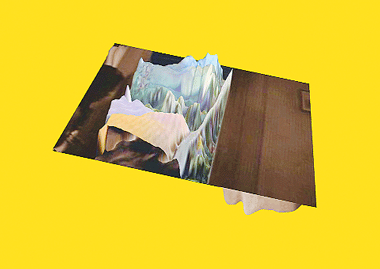The visionary remediations of Michael Joaquin Grey
There’s something about innate intelligence that makes people stop and reflect. Whether it’s an envious desire to obtain their knowledge or a trusting wonder about how their brain works, gifted minds attract an audience. The trick for these select few is to figure out a way to integrate their intellectual impulses into an effective avenue, to figure out a way to channel their ideas so that at the end of the day, there is, in some way, an advance that wasn’t there before. Although these channels tend to be the usual suspects—science, academia, law, etc.—the art of new media has become a harbor to innovators and provocative thought.
Michael Joaquin Grey is an artist that has engendered his BA in genetics from the University of California at Berkeley with his MFA from Yale to create an overwhelming resume of award-winning new media exhibitions. His new solo exhibition gives the viewer a chance to encounter thoughtful artwork from a brilliant and established visionary. Although Grey’s integration of classical science and modern technology can give off an immediate sense of human disconnection, after exploring the details and aesthetic force of his work, the disconnection becomes a value. By breaking down the cultural acceptance of repeated, traditional visuals, Grey is able to use metaphysical foundations to rebuild these images using sensory experience as a way to construct meaning.
Algorithms. To many, the word elicits humbleness or memories of cram sessions for calculus. For Grey, algorithms are written as an integral part of his creative process. By inputting his formulas into personally crafted software that musical artist Luke DuBois engineered, he creates recurring manipulations and sound to affect the appearance of found footage and digital imagery.
“Reentry” and “Rereentry” are positioned in the gallery back-to-back, reinforcing their causal relationship. “Reentry” uses form and space to recreate an educational biology film that features a woman giving birth played in reverse. The software gives a digital aesthetic to the film image, which rotates on a vertical axis.
“Rereentry” consists of two images, clips from a pornographic film on one side, and the same scene featured in “Reentry” of the woman giving birth on the other side. These images are made up of small film cells projecting the same scene that they combine to display. Unlike the “Reentry” film, “Rereentry” is not shown in reverse. Although these works are open to interpretation, themes of scale, form, and the origin of life are some ideas that Grey tries to interpret in these pieces.
“Perpetual ZOOZ” uses footage from “The Wizard of Oz” to illustrate how culturally celebrated images would appear in 3D in what the artist calls Möbius orbit. The scenes rotate on a horizontal plane and resemble the composition of a relief map when turned upright.
Grey’s New York invitation to “REENTRY” is one that needs to be accepted. Sometimes citing an article is enough when discussing the latest Chelsea exhibitions at a cocktail party, but in this case, words can’t possible do justice to the sensory and personal experience that Grey has created.
gaycitynews.com


































